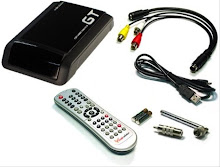An ATSC tuner, often called an ATSC receiver or HDTV tuner, allows reception of ATSC digital television (DTV) signals broadcast over-the-air by TV stations in North America and South Korea. Such tuners may be integrated into the television, VCR, digital video recorder, and set-top box which provides audio/video output-connectors of various types.
Technical overview
The terms "tuner" and "receiver" are used loosely, and it is perhaps more appropriately called an ATSC receiver, with the tuner being part of the receiver (see Metonymy). The receiver generates the audio and video (AV) signals needed for television, and performs the following tasks: demodulation, error correction, transport stream demultiplexing, decompression, AV synchronization, and media reformatting to match what is optimal input for one's TV. Examples of media reformatting include: interlace to progressive scan or vice versa, picture resolutions, aspect ratio conversions (16:9 to or from 4:3), frame rate conversion, even scaling. Zooming is an example of resolution change. It is commonly used to convert a low-resolution picture to a high-resolution display.
From Wikipedia, the free encyclopedia

ATSC tuner
Subscribe to:
Post Comments (Atom)
Labels
- ATSC tuner (1)
- Cable CARD Tuner (1)
- Dvico Fusion Dual HDTV DVB-T Tuner (1)
- Fusion HDTV (1)
- HDTV (2)
- HDTV PC Tuner Guide (1)
- HDTV Receiver (1)
- HDTV Tuner (2)
- HDTV Tuner Cards (2)
- HDTV Tuner Review (1)
- How an ATSC Tuner Works (1)
- New Technology (1)
- Samsung (1)
- samsung hdtv tuner cards (1)
- The Best HDTV Tuner for Your PC (1)
- Tuner (radio) (1)
- What is HDCP? (1)
0 comments:
Post a Comment